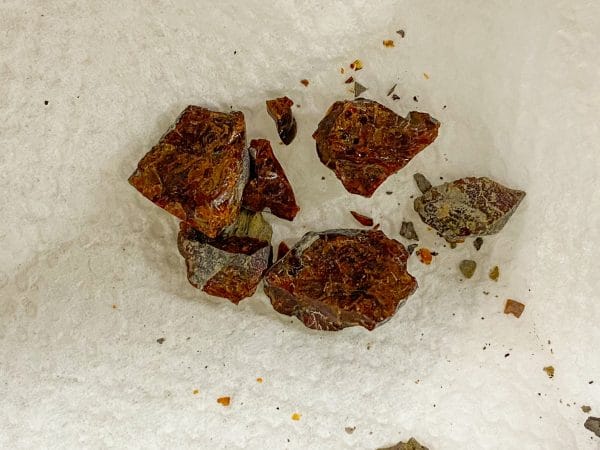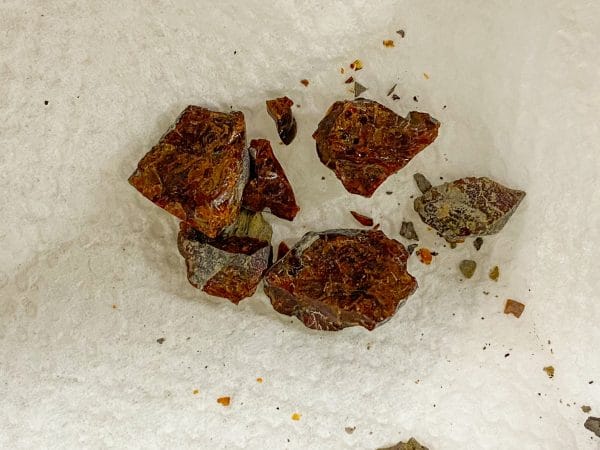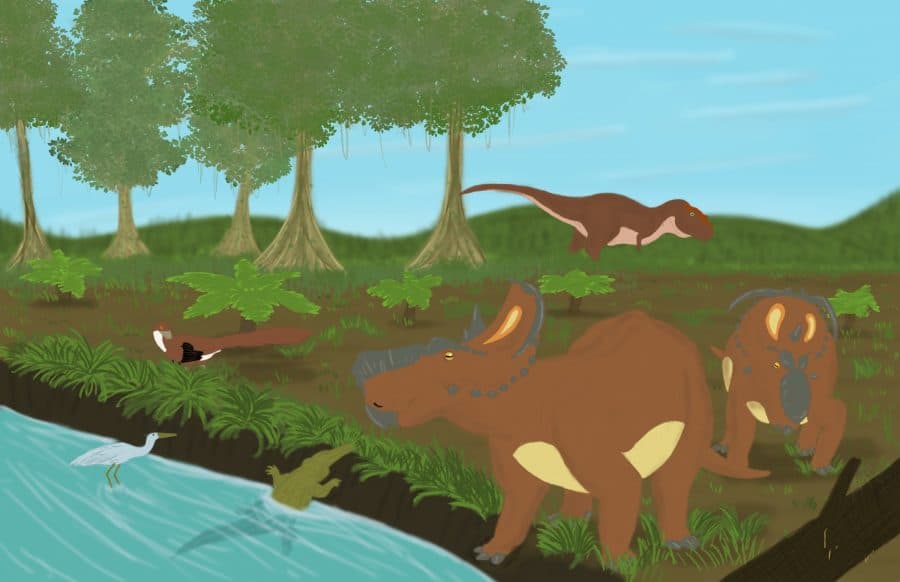
Many of us are familiar with amber thanks to, of course, Jurassic Park. It’s often thought of as that yellowish, cloudy rock made of fossilized tree sap often containing prehistoric insects with the potential to bear the incredible resource of preserved dinosaur DNA. However, as with most things dealing with palaeontology in pop culture, the truth is different than what you see on this screen.
Amber is a real thing, yes, and it does originate from trees. However, amber is generally derived from fossilized tree resin as opposed to sap. Resin is a much thicker, stickier fluid made by plants. It’s composed of organic compounds called terpenes, and is used by the plant to protect itself from predatory insects and diseases. When something gets into a living tree trunk, for example, the tree will ooze resin at the site of the injury, and the resin prevents foreign invaders from getting into the tree. As it dries it hardens into a crusty, sticky chunk. In this way, resin acts a bit like a scab you might get after receiving a cut. If a tree happens to be buried and fossilized, resin attached to it might then fossilize and become amber.
It’s also true that, while the resin is still soft and gooey, small animals, or parts of slightly larger animals, may become trapped inside it. If that resin fossilizes into amber, anything biological that got caught inside will become fossilized too, sometimes in immaculate detail. This doesn’t mean, though, that living things trapped in amber (known as inclusions) are sort of frozen in time, with all their associated tissues and biomolecules locked in stasis forever. While it was once believed that amber could preserve biological molecules like DNA for hundreds of millions of years (Bada et al., 1999), no one has yet successfully found intact tissue or biomolecules in amber. This means you shouldn’t get your hopes up about dinosaur DNA and cloning possibilities from amber any time soon.
All of that said, though, resin fossils are still amazing to look at, and can preserve animals, or parts of animals, that would normally never fossilize in rock. Countless arthropods like insects are commonly found, as well as things as small as fossilized bacteria (Waggoner, 1996), but we also have things like prehistoric lizards (Daza et al., 2016) and amphibians (Matsumoto & Evans, 2018) (Xing et al., 2018a). There’s even several parts of weird extinct birds called enantiornitheans which have revealed much about the biology of these early proto-birds (Xing et al., 2016a) (Xing et al., 2017) (Xing et al., 2018b) (Xing et al., 2019a) (Xing et al., 2019b) (Xing et al., 2020a). Perhaps the most interesting of all (at least to dinosaur fans), a feathered tail segment from a small nonavian dinosaur was described (Xing et al., 2016b), providing further evidence that many of these animals were feathered, and revealing much about the evolution of feathers in dinosaurs. More recently, the controversial Oculudentavis was described. Initially thought to be a bizarre and tiny primitive bird (Xing et al., 2020b), many other palaeontologists argued online that the creature was actually a misidentified lizard. The authors who described the animal even retracted their avian identification (Xing et al., 2020c) and a recent description of a second Oculudentavis specimen seems to confirm its status as a tiny, strange lizard (Bolet et al., 2020).
This is where we must get into an important and serious caveat, however. Much of this palaeontological knowledge comes at a price, one that is shown to be far too steep to be worth the wisdom gained. Most of the above mentioned amber fossils come from Myanmar, where there are rich mines of amber harvested to be sold for jewelry. Sometimes the mined amber contains fossils, and can be acquired afterwards by palaeontologists for scientific study (often at an immense price). The unfortunate reality, though, is that the working conditions of these mines are both deplorable and dangerous, and highly exploitative of the (often young) workers forced down into hazardous settings to haul out the amber. Furthermore, amber sales from these mines are reported to have been used to fund the ongoing violence in the region between different warring factions. Much of this was not widely known to the rest of the world, including many palaeontologists, until just after the Oculudentavis description. All in all, with so much violence and death associated with Myanmar amber now made clearer, some palaeontologists quickly began to argue that it was downright unethical to publish on and study Myanmar amber. The Society of Vertebrate Palaeontology agreed, and asked journal editors to cease publishing studies on Myanmar amber (Rayfield et al., 2020), and some prominent journals have stated they will no longer accept papers on the subject. This dilemma is beyond the scope of this article to fully cover, but was necessary to mention, so please do read more on it here, here, here, and here.
The main reason we’re here today, however, is to talk about some recent findings in a much more low-key amber location. The Pipestone Creek bonebed, one of gems of northern Alberta palaeontology, is most famous for its massive accumulation of Pachyrhinosaurus fossils, with a few other dinosaur taxa mixed in. Another thing that Pipestone is rich in, unbeknownst to many people, is amber. It’s not nearly as productive as a commercial mine by any means, with most amber pieces ranging from the size of a kernel of corn to a grain of sand, but you don’t have to search terribly hard at the Pipestone bonebed to find some amber either. The Philip J. Currie Dinosaur Museum has many small vials of the stuff collected over the past few years, and I’ve found amber nearly every time I’ve partaken in excavations there.

Amber collected from Pipestone Creek. The larger pieces are roughly corn kernel-sized. Photo by Nicholas Carter.
Amber at the Pipestone bonebed is cool and noteworthy for a couple reasons. One is that Pipestone Creek is one of the few locations in the world where dinosaur fossils and amber are found in the exact same spot. Secondly, Pipestone amber sometimes has creatures inside, and we can study these to learn a lot more about the environment that the doomed herd of Pachyrhinosaurus existed in. A relatively recent study, in fact, has done just that.
Cockx et al., 2020 sought to study Pipestone amber collected over the years to figure out what kinds of small critters were around at the time, and what the environment they lived in was like. This is pretty important work, as the palaeoecology of northwestern Alberta is still fraught with mystery and uncertainty. We’re only just getting to know all the dinosaurs up here, as well as the creatures they coexisted with.
For decades now the Pipestone Creek bonebed has been the most reliable fossil location in this area, representing a rock unit called the Wapiti Formation which overlaps in time with much of southern Alberta’s better-understood badlands. This bonebed (and several others in the area) actually coincides with a gap in our knowledge of dinosaur evolution in Alberta, having been laid down when much of the dinosaur-rich southeast was beneath the Western Interior Seaway. Thanks to Pipestone, we know that northwestern Alberta was also home to dinosaurs, not just Pachyrhinosaurus but also species of tyrannosaur, dromaeosaur, and troodontid, whose teeth are present at the sight. Traces of lizards, turtles, freshwater fish, and crocodiles have also come from here. Nothing terribly unusual for late Cretaceous North America. If we want to know more details about the environmental conditions at this site, however, we’ll want to study the amber.
Cockx et al., 2020 discovered some pretty neat things in the amber that has come out of Pipestone over the years. First off, some of it contains a variety insects. One turned out to be a new species of the genus Archaeromma, a member of a mysterious family of microscopic wasps called the mymarommatids. There’s also a new genus of booklice, tiny little scavenging insects, called Cretolepinotus tankei found in Pipestone amber. The specific name of this new insect is in honor of Royal Tyrrell Museum palaeontologist Darren Tanke, who did much early work in the bonebed and first reported inclusions in the amber from there. A little harder to interpret were also some kind fossil spider and aphid in the amber, as well as some kind of fungal or bacterial filaments.
Along with these neat invertebrates, the authors also discovered a small cluster of filamentous bird feathers in a piece of amber. This specimen even had hints of colour, with some filaments appearing dark while others may have been pale or white in life. The exact identity of the bird who left this feather behind remains a mystery, but the authors noted it bears a resemblance to the feathers of aquatic and marine birds alive today. This means that the bird who left this feather likely spent a lot of time in or around water. Even though Pipestone Creek wasn’t really close to the coast at the time, being a couple hundred kilometers inland to the west back then, it’s far from impossible that a flying coastal bird could have made its way some distance inland and left a feather behind, perhaps while perching in a tree. This even happens today in landlocked places such as modern day Alberta on occasion. Some birds, such as loons and cormoronts, migrate between coastal and inland freshwater regions throughout the year, so the bird in questions may not have been a saltwater specialist as well. The authors suggested hesperornithine or ichthyornithine birds as likely possibilities for the origin of this feather. These toothed birds appear to have lived in and around the Western Interior Seaway, though flying species may have wandered inland. They also have no close living relatives, having gone extinct at the end of the Cretaceous, and so a feather from one of these birds would be a cool find.
The authors could also tell a thing or two about the environmental conditions at the time that the Pipestone amber was preserved. The chemical isotopes in the amber are very similar to those found in late Cretaceous amber from other parts of Alberta, and show no signs of ecological stress on the trees from things like droughts, fires, or insect attacks. This means the forest in this area was fairly healthy right before the disaster that wiped out a Pachyrhinosaurus herd as well as many other living things in the area. Pipestone amber has a very similar chemical structure to that of modern trees in the cypress and redwood family, Cupressaceae, which were common in Cretaceous Alberta. Amber from the Edmontosaurus bonebed in Edmonton shows this similarity as well, and it bears remains of the extinct cypress tree Parataxodium, meaning that Edmonton amber, and most likely Pipestone amber too, largely came from this type of tree.
They could also tell something about the water in the region at the time, which appears to have been a densely forested area dotted with rivers and lakes. A little bit of the rain that fell in the area had evaporated from the Western Interior Seaway. That said, the trees were still mostly fed by inland water, with the authors comparing the site to modern day central New Brunswick- somewhat influenced by water from the sea, but still an inland environment.
Furthermore, the authors could estimate the ambient temperature at the time the amber formed, which looked to be around 26 degrees Celsius. Temperature is something that has made a lot of palaeontologists who study northern dinosaurs stop and think. Seasons weren’t nearly as extreme during the Cretaceous, and summers in high latitudes were easily as warm or warmer than they are today (26 degrees is a pretty balmy summer day in modern Grande Prairie). But how did all these seemingly mild temperature-loving animals fare in the colder months? Cockx et al., 2020 note that the distribution of higher temperatures in the late Cretaceous were different than they are today. While tropical areas around the equator had essentially the same temperature conditions as they do today, higher latitudes saw disproportionately higher temperatures compared to modern ones the further away from the equator you went. This means that, instead of the stark contrast in conditions you’d see today between places like northern Alberta and the equator, especially during the winter, there was radically less difference back then, with polar regions being on average 15 degrees warmer, making for a significantly milder climate for reptiles and such to thrive in. It may have also been pretty humid at Pipestone 73 million years ago, since modern relatives of the insects found in the amber there tend to live in warm, humid areas today. Combine that with the presence of turtles, lizards, and crocodiles, creatures that haven’t changed much in shape and habitat preference since the late Cretaceous, and you’re looking at an area that was warm and humid much of the time.
Thanks to the tiny find in Pipestone Creek amber, and studies of the amber’s chemistry, we can begin to imagine the site as it was back then with much greater clarity. Picture yourself there, 73.27 million years ago. A vast, dense woodland carved up by broad rivers and dotted with muddy lakes and swampy wetlands. Cypress trees, towering pillars of green and brown, dominate the canopy and darken the forest below. Flowering shrubs, ferns, and horsetails fill out the understory. Spongy moss creeps across the brown tree trunks. Insects buzz in the air, crawl through the leafy vegetation, and wriggle across the damp forest floor. Small mammals chase bugs under fallen logs, and they in turn are pursued by large, carnivorous lizards. Crocodiles bask on the river banks, and the ponds are alive with turtles and amphibians. Gull-like birds circle in the sky, looking for garfish to pluck from the greenish-brown rivers. Big, three-toed tracks crisscross along muddy trails worn into the vegetation, indicating the presence of larger animals. Some are narrow with pointed claws- perhaps a tyrannosaur passed through in the night, following a small group of hadrosaurs. Its kill may provide an easy scavenging meal for birdlike dromaeosaurs and troodontids in the area. In the distance, a chorus of low grunts and snapping vegetation herald an enormous Pachyrhinosaurus herd wandering and browsing through the woodland. In the distance, dark storm clouds build on the horizon, threatening disaster upon the inhabitants below.
One of the coolest things about palaeontology is how even the smallest fossils can paint such a vivid picture of a distant past that exists only in the rock around us. And in our minds.

A rough idea as to what Pipestone Creek looked like 73 million years ago. By Nicholas Carter.
References
Arnau Bolet, Edward L. Stanley, Juan D. Daza, J. Salvador Arias, Andrej Čerňanský, Marta Vidal-García, Aaron M. Bauer, Joseph J. Bevitt, Adolf Peretti, Susan E. Evans. “The tiny Cretaceous stem-bird Oculudentavis revealed as a bizarre lizard”. bioRxiv 2020.08.09.243048; doi: https://doi.org/10.1101/2020.08.09.243048
Pierre Cockx, Ryan McKellar, Ralf Tappert, Matthew Vavrek, Karlis Muehlenbachs. Bonebed amber as a new source of paleontological data: The case of the Pipestone Creek deposit (Upper Cretaceous), Alberta, Canada. Gondwana Research, Volume 81, 2020, Pages 378-389, ISSN 1342-937X, https://doi.org/10.1016/j.gr.2019.12.005.
Daza, Juan D.; Stanley, Edward L.; Wagner, Philipp; Bauer, Aaron M.; Grimaldi, David A. (March 2016). “Mid-Cretaceous amber fossils illuminate the past diversity of tropical lizards”. Science Advances. 2 (3): e1501080.
J.L. Bada, X.S. Wang, H. Hamilton (1999). “Preservation of key biomolecules in the fossil record: Current knowledge and future challenges”. Philos Trans R Soc Lond B Vol. 354. p. 77-87.
Matsumoto, Ryoko; Evans, Susan E. (2018-01-03). Smith, Thierry (ed.). “The first record of albanerpetontid amphibians (Amphibia: Albanerpetontidae) from East Asia”. PLOS ONE. 13 (1): e0189767.
Rayfield, Emily J.; Theodor, Jessica M.; Polly, P. David (2020). Fossils from conflict zones and reproducibility of fossil-based scientific data. Society for Vertebrate Paleontology. pp. 1–2.
Waggoner, Benjamin M. (13 July 1996). “Bacteria and protists from Middle Cretaceous amber of Ellsworth County, Kansas”. PaleoBios. 17 (1): 20–26
Xing, Lida; McKellar, Ryan C.; Wang, Min; Bai, Ming; O’Connor, Jingmai K.; Benton, Michael J.; Zhang, Jianping; Wang, Yan; Tseng, Kuowei; Lockley, Martin G.; Li, Gang (2016-06-28). “Mummified precocial bird wings in mid-Cretaceous Burmese amber”. Nature Communications. 7 (1): 12089.
Xing, Lida; McKellar, Ryan C.; Xu, Xing; Li, Gang; Bai, Ming; Persons, W. Scott; Miyashita, Tetsuto; Benton, Michael J.; Zhang, Jianping; Wolfe, Alexander P.; Yi, Qiru (December 2016). “A Feathered Dinosaur Tail with Primitive Plumage Trapped in Mid-Cretaceous Amber”. Current Biology. 26 (24): 3352–3360.
Xing, Lida; O’Connor, Jingmai K.; McKellar, Ryan C.; Chiappe, Luis M.; Tseng, Kuowei; Li, Gang; Bai, Ming (September 2017). “A mid-Cretaceous enantiornithine (Aves) hatchling preserved in Burmese amber with unusual plumage”. Gondwana Research. 49: 264–277.
Xing, Lida; O’Connor, Jingmai K.; McKellar, Ryan C.; Chiappe, Luis M.; Bai, Ming; Tseng, Kuowei; Zhang, Jie; Yang, Haidong; Fang, Jun; Li, Gang (February 2018). “A flattened enantiornithine in mid-Cretaceous Burmese amber: morphology and preservation”. Science Bulletin. 63 (4): 235–243.
Xing, Lida; Stanley, Edward L.; Bai, Ming; Blackburn, David C. (December 2018). “The earliest direct evidence of frogs in wet tropical forests from Cretaceous Burmese amber”. Scientific Reports. 8 (1): 8770.
Xing, Lida; McKellar, Ryan C.; O’Connor, Jingmai K.; Bai, Ming; Tseng, Kuowei; Chiappe, Luis M. (2019-01-30). “A fully feathered enantiornithine foot and wing fragment preserved in mid-Cretaceous Burmese amber”. Scientific Reports. 9 (1): 927.
Xing, Lida; McKellar, Ryan C.; O’Connor, Jingmai K.; Niu, Kecheng; Mai, Huijuan (2019-10-29). “A mid-Cretaceous enantiornithine foot and tail feather preserved in Burmese amber”. Scientific Reports. 9 (1): 15513.
Xing, Lida; McKellar, Ryan C.; O’Connor, Jingmai K. (February 2020). “An unusually large bird wing in mid-Cretaceous Burmese amber”. Cretaceous Research. 110: 104412.
Xing, Lida; O’Connor, Jingmai K.; Schmitz, Lars; Chiappe, Luis M.; McKellar, Ryan C.; Yi, Qiru; Li, Gang (March 2020). “Hummingbird-sized dinosaur from the Cretaceous period of Myanmar”. Nature. 579 (7798): 245–249.
Xing, L.; O’Connor, J. K.; Schmitz, L.; Chiappe, L. M.; McKellar, R. C.; Yi, Q.; Li, G. (22 July 2020). “Retraction Note: Hummingbird-sized dinosaur from the Cretaceous period of Myanmar”. Nature. doi:10.1038/s41586-020-2553-9

